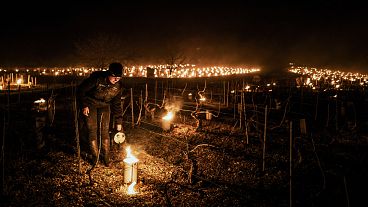This wine has been grown high in the Bolivian Andes since the 17th Century and it could have some health benefits.
Bolivian wine-growers in Tarija are continuing a centuries-old tradition in a bid to join the world stage with their unique and potentially healthy wines.
In the department of Tarija, southern Bolivia, little known vineyards are producing wine almost 2,000m above sea level. They have been growing grapes here since Jesuit missionaries started the tradition in the 17th Century.
The wine production is mostly concentrated at an altitude of 1,600m to 2,000m. However, in hot Andean regions there are some crops as high as 3,000m.
"Winemaking in the rest of the world ends where we begin,” says Helmut Kohlberg, Vineyard Director at Bodegas Kohlberg.
“In all parts of the world, the winemaking is at sea level, 800m, 1000m, a little more. But we only start to have wine making at this altitude."
How can wine be good for me?
The 5,000 hectares of vineyards in Tarija are sheltered from strong winds and benefit from a temperate climate with intense sunshine during the day and humidity at night.
"The altitude means that we have less ozone layer filtering the rays, which means there's more ultraviolet rays at higher altitudes ... which produces a response from the plant," explains Nelson Sfarcich, a wine making expert.
The strong UV rays cause the grapes to grow thicker skins. Grape skins contain resveratrol, a chemical that some studies have suggested can help protect against cancer and heart disease. The thick skinned grapes grown in this area contain a higher level of resveratrol than those grown at lower altitudes.
How does high altitude wine taste?
Wines from vineyards at altitude supposedly appeal to those that "like elegant wines”.
“They're wines that don't have a very high alcohol content, but rather they have smooth aromas and flavours that are strong at the same time," says Maria Jose Granier, owner of the artisanal Jardin Oculto vineyard.
The well-known Muscat of Alexandria grape, used in 70 per cent of Bolivia’s wine crops, produces "sweet wines that are quite aromatic," according to Carla Molina Garcia, an independent sommelier.
It is the aromatic nature of these high altitude wines that is pushing growers to target a niche, high-quality market.
But Bolivian vineyards have their neighbours in Argentina and Chile to compete with. As the seventh and eighth largest wine producers in the world respectively, the two countries have around 200,000 hectares of vineyards between them.
Though there is limited physical space for the producers in Tarija to be able to expand production, they are striving to improve the quality of their product and hope that Bolivia will become known for its distinctive wines.
Watch the video above to see these incredible high altitude vineyards.



